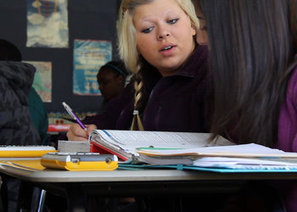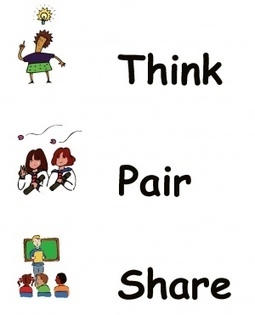 Your new post is loading...
 Your new post is loading...
The ultimate goal of teaching is to do just that - teach, not stand up in the front of the room and talk. But sometimes it's easier to talk than to teach
Teachers often talk about the vital nature of their work and the fact that for the young people we teach there are no second chances. I’ve heard teaching compared to air traffic control and the risks in the classroom compared to the risk involved in miscalculating the landing of a plane. These kinds of comparison

|
Rescooped by
Mel Riddile
from EdD etc.
|
Interactive Sesame Street, Nat Geo TV come to Microsoft Kinect... The skinny: For decades, educational video games have failed to get a rise out of kids and parents; that 1985’s The Oregon Trail is still the genre’s most well-known is telling. You could say that Microsoft aims to shake that perception with its two newest apps for the Xbox 360, Kinect Sesame Street TV and Kinect Nat Geo TV, but Microsoft has said proudly that these are not games. Instead, the shows combine pre-recorded videos with Kinect’s motion and voice sensors, and the results are two entirely different tacks on adding interactivity to standard TV series.
Via Marianne Riddile

|
Scooped by
Mel Riddile
|
Under the Common Core State Standards teacher will address fewer standards in more depth. In addition, students must use high-order thinking, argumentative writing, and application to real-world situations. Frequent checks for understanding must become a normal part of instruction in every classroom every day.-Mel Riddile
"As teachers we create conditions for our students to learn. As we plan it is critical to create opportunities that keep students engaged in the learning process.
The outcome of this process is to determine if students have reached our learning targets. In order to know if students have learned the concept(s) taught, formative assessment data should be collected to check for our students’ understanding. These can be short preplanned activities that serve as a closure to a specific lesson. The data collected will help develop the your next steps."
- Where are my students headed?
- Where are they right now?
- How can I close the gap between where they are and where I want them to be?

|
Scooped by
Mel Riddile
|
Psychology Today
http://www.psychologytoday.com/blog/brain-candy/201201/everything-you-thought-you-knew-about-learning-is-wrong
Taking notes during class? Topic-focused study? A consistent learning environment? All are exactly opposite of the best strategies for learning.
Interleaving
First, he told me, think about how you attack a pile of study material. “People tend to try to learn in blocks,” Bjork said. “Mastering one thing before moving on to the next.” Instead of doing that Bjork recommends interleaving. The strategy suggest that instead of spending an hour working on your tennis serve, you mix in a range of skills like backhands, volleys, overhead smashes, and footwork. “This creates a sense of difficulty,” Bjork said. “And people tend not to notice the immediate effects of learning.” Instead of making an appreciable leap forward with your serving ability after a session of focused practice, interleaving forces you to make nearly imperceptible steps forward with many skills. But over time, the sum of these small steps is much greater than the sum of the leaps you would have taken if you’d spent the same amount of time mastering each skill in its turn. Bjork explains that successful interleaving allows you to “seat” each skill among the others. “If information is studied so that it can be interpreted in relation to other things in memory, learning is much more powerful,” he said. There’s one caveat: Make sure the mini skills you interleave are related in some higher-order way. If you’re trying to learn tennis, you’d want to interleave serves, backhands, volleys, smashes, and footwork — not serves, synchronized swimming, European capitals, and programming in Java.
Studying in one location
Studying in only one location is great as long as you’ll only be required to recall the information in the same location. If you want information to be accessible outside your dorm room, or office, or nook on the second floor of the library, Bjork recommends varying your study location.
Spacing
Interleaving and varying your study location will help whether you’re mastering math skills, learning French, or trying to become a better ballroom dancer. A somewhat related phenomenon — the spacing effect, which was first described by Hermann Ebbinghaus in 1885 — will also help. “If you study and then you wait, tests show that the longer you wait, the more you will have forgotten,” Bjork said.
But here’s the cool part: If you study, wait, and then study again, the longer the wait, the more you’ll have learned after this second study session. Bjork explains it this way: “When we access things from our memory, we do more than reveal it’s there. It’s not like a playback. What we retrieve becomes more retrievable in the future. Provided the retrieval succeeds, the more difficult and involved the retrieval, the more beneficial it is.
Practice Retrieval
Bjork also recommends taking notes just after class, rather than during — forcing yourself to recall a lecture’s information is more effective than simply copying it from a blackboard. You have to work for it. The more you work, the more you learn, and the more you learn, the more awesome you can become.
Created for a presentation - geared for those working with HS and college age students.
Via JackieGerstein Ed.D.

|
Scooped by
Mel Riddile
|
via Teaching Channel
Video: Math teacher, Leah Alcala, engages students by using a warm-up problem at the beginning of every class.
Materials and Resources: Index Cards, Document Camera, LCD Projector
This is a great "bell ringer," or "do now" activity.
This 5:00 minute video also demonstrates the following: - Creating a low-threat classroom environment
- Low-cost strategies
- Formative Assessment
- Check for Understanding
- Whole-Class Instruction
- Questionning Strategies
- Guided Practice
- Differentiation
- Teach and Re-teach
- Higher-Order Thinking (Analyze, Evaluate)

|
Scooped by
Mel Riddile
|
Read another essay he's written titled Differentiated Instruction: Setting the Pedagogy Straight.
No Silver Bullet
There is no one book, video, presenter, or Website that will show everyone how to differentiate instruction. Let's stop looking for it. One size rarely fits all. Our classrooms are too diverse and our communities too important for such simplistic notions.
What is differentiation?
Instead, let's realize what differentiation really is: highly effective teaching, which is complex and interwoven; no one element defining it.
A Mindset Professor and differentiation expert, Diane Heacox, reminded me a few years ago that
"Differentiation is foremost a mindset. It's only 10% craft and mechanics of pulling it off." - Diane Heacox
Formative Assessments = Key
Without the focus on formative assessment and adjusting learning in response to what it reveals, however, these students drift with needs unmet, academic potential dwindling.
It's about how students learn best!
Many of us are guilty of that from time to time - teaching the way we best learn, not the way our students best learn, myself included.
In a successful differentiated class, we stop hiding behind the factory model of teaching. We teach in whatever way students best learn, even if that's different student to student, or different from the way we best learn ourselves.
If a student needs more, less, or a different challenge, we provide it as we can.
Who "gets it first"
Most schools conspire against this, unfortunately. As institutions, they are designed to meet the needs of students who "get it" first or easiest.
Accepting differentiation more as a collection of principles about responsive teaching than a collection of quick recipes for someone's diversity cookbook is my first piece of advice, as practical as those recipes may be.
Suggestions
Mitigating the negative aspects of the factory model of schooling is my second. In addition to these, I suggest we:
• Green and growing or ripe and rotting! - Build our personal capacity for creative thinking and problem-solving. • Read and converse professionally. The best differentiation teachers I know read professional journals, books, and/or blogs regularly, and they take the time to discuss their ideas with colleagues in and out of their buildings. • Less is More! Lower our professional standards. Yep, I said to lower them. So many of us are trying to do everything wise and wonderful every single day in the classroom while dealing with teacher-bashing media and an impoverished, ever-increasing class-size world. It's too much; we have to conserve what little energy we have left at the end of the day for ourselves and families. Since we can't do it all, we end up not doing any of it. Instead, try one differentiation idea per month for three years. Give yourself time and space to improve. • Is it working? Spend considerable time demonstrating to yourself and others how your assessments - pre-, formative, summative, common - inform your instructional decisions. We don't put students into small groups, for example, because that is what differentiating teachers do. • Know your students! Construct a solid understanding of the unique nature of the students you serve. There are universal characteristics about how brains of all ages learn, but there are very specific characteristics of the 12 year-old's brain that we don't find in the brains of 18 year-olds or the brains of 6 year-olds. Let's articulate these differences and respond to them in our lessons.
With Students, Not To Students
Finally, I highly recommend teachers see teaching as something they do with students, not to students. It's a collaboration to conduct the enterprise of schooling, and every successful classroom I've ever found embraced a modified democracy and mutual ethos of respect between student and teacher.

|
Scooped by
Mel Riddile
|
What is a "flipped class?"
The flipped class is a type of blended learning, which combines online and traditional face-to-face methods. Students can review videos at their own pace, pausing to take notes or review a point. While the number of educators using this method is tough to calculate, 2,500 have joined the Flipped Class Network, a learning community for teachers using vodcasting (video podcasting) in class.
How do teachers "flip" their lessons? - Teachers use Camtasia screen-recording software that allows them to speak over a PowerPoint presentation and to create and upload videos in different formats.
- Videos from the Khan Academy, a nonprofit organization that offers a library of 2,600 video tutorials, are also used.
- Teachers can upload their videos to a school Web site, Edmodo or use learning management systems such as Blackboard or Desire2Learn.
Critics advise caution? - Some critics, including Lisa Nielsen, author of Teaching Generation Text, say educators should use the flipped classroom with caution because many students do not have access to computers outside of school.
- CHS does not have a one-to-one laptop program, but students can watch the videos on computers in class or use their own device.
- Those opposed to the flipped classroom say that students won’t watch the videos at home because it’s still homework and lecture is not the best teaching method for all students.
Potential to "personalize" learning
Susan Patrick, CEO of the International Association for K-12 Online Learning, says the flipped class method has the potential to improve personalization of instruction and increase student-teacher interaction and peer-to-peer learning.
Implementation 4 Keys
“The key is in the implementation and the fidelity for using research-based practices including teh following: - increasing peer-to-peer interaction
- focusing discussions on key learning objectives,
- enabling effective teaching interventions
- assuring that students are demonstrating the knowledge and skills at high levels of proficiency along the way

|
Scooped by
Mel Riddile
|
Now some provocative research suggests that a part of the problem might be that obesity could change the area of the brain that helps control appetite and body weight.
And those changes might start within a day of eating a high-fat meal, according to scientists who are trying to figure out why it's so hard to lose weight. They report seeing changes in the brain after just one day on a fatty diet.

|
Scooped by
Mel Riddile
|
Rubrics for:
Assessment Information,
Cooperative Learning,
Research Process/Report
PowerPoint/Podcast,
Oral Presentation,
Web Page and ePortfolio,
Math,
Art,
Science,
Video and Multimedia Project ,
Creating Rubrics,
Writing,
Rubrics for Primary Grades...
|
Rick Wormeli, the well-known educator, author, and speaker, has agreed to provide the primary response today. In addition, several readers contributed their own thoughts.
A compilation this week... Learning and Revision It's still revision time with public examinations coming up and for our school we can add the younger students too as they will have school exams. C...

|
Scooped by
Mel Riddile
|
Few topics arouse such strong passion as how best to teach children to read. This Spotlight focuses on research on what works in teaching reading and successful tools and tactics already at work in classrooms.

|
Scooped by
Mel Riddile
|
Children’s spontaneous curiosity compelled them to explore aspects of their environment that challenged their current theories, and therefore had the potential to teach them something new.
Curiosity paved the way for learning.
The Common Core State Standards call for both increased student engagement and the teaching of collaborative skills.
Learning is a collaborative venture. The more we can provide opportunities for our students to think, collaborate and learn from each other – the more we are preparing them for their futures!...

|
Scooped by
Mel Riddile
|
By Marlene Cimons, National Science Foundation
If a teacher puts out too much new information in the final minutes of a class, students might have trouble “getting” it.
If you have a final exam in six weeks, it might be better to study for it now and then again next week, rather than tonight and tomorrow.
“It depends, to some extent, on when you have to remember it,” says Gary Cottrell, a professor in the computer science and engineering department at the University of California at San Diego.
“Cramming the night before a test is okay, but if it’s something you need to know a month from now, spacing between study sessions makes a big difference.”
"Timing is everything!"
In other words, timing is everything. This is the underpinning for the work of the Temporal Dynamics of Learning Center, whose goal is to understand the impact of timing in learning across brain and social systems.
“Time is an understudied variable,” says Cottrell, who directs the center.
“Timing is crucial in learning from the synaptic levels--connections between neurons--to long-time scales, like months and years.”

|
Scooped by
Mel Riddile
|
The Flipped Classroom is an inverted method of instruction where teaching and learning take place online outside of the class while homework is done in the classroom.
Advocators of this approach believe that this is the ideal method of instruction in our digital age. They basically build their judgement on the following facts : - Flipped Classroom shifts the learning responsibility and ownership from the teacher's hands into the students'.
- Students tend to perform better when they control when, where and how they learn.
- Teachers no longer dispense knowledge but rather guide and direct while students are the real active learners
- Teachers create animated videos and interactive lessons and lectures and students access them at home in advance of class even. In this way all students can re-watch the video tutorials whenever they want.
- Classroom time can be geared towards data collection, collaboration, and application.
- Class becomes a place for students to work through problems, advance concepts, and engage in collaborative learning.
- Flipped Classroom also "allows teachers to reflect on and develop quality and engaging learning opportunities and options for internalization, creation, and application of content rather than just fluff or time filling assignments."

|
Scooped by
Mel Riddile
|
Thanks to Larry Ferlazzo's blog, I found out about a new animated Word Cloud generator. What I like about it, is that the site supplies you w/ the embed code (it is a bit robust) which allows users to customize it and use the generator anyway they see fit.

|
Scooped by
Mel Riddile
|
Don't believe the hype!
New reports find that multi-taskers are “lousy at everything that’s necessary for multi-tasking.”
Considering the amount of time people spend with around-the-clock access to TV, the Internet and mobile devices, it’s not surprising.
This infographic looks at the causes and effects of multi-tasking.

|
Scooped by
Mel Riddile
|
Carol Tomlinson
"My view of differentiation is still much the same. It's not a mystery formula that only a few can understand. It's not a series of mandatory instructional strategies. It's not a recipe. It's problem solving on behalf of kids. One step at a time, all teachers can do that. Working with like-minded colleagues makes the journey smoother and more rewarding."
Carol's Suggestions:
1) Start small. Start with one subject or one class. Start with 10 minutes a day or 15 minutes a week. Just start. 2) Study your students. The more you see them as distinct individuals--the more you understand them as human beings--the clearer your motivation will be. 3) Use formative assessments regularly 4) Invest time in thinking through classroom routines--giving directions, handling transitions, starting and stopping tasks, using materials effectively. Envision how you want things to work and help your students do the same. 5) Make the students your partners in creating a classroom that works well for everyone. Get their input on which approaches work best for them.
"Differentiation just asks of us what we commend for our students: flexible thinking, intellectual risk-taking, problem-solving--and a deepening sense of humanity."

|
Scooped by
Mel Riddile
|
Four-to-One
In the mid 1970s I worked with Fran Tarkenton and Aubrey Daniels at Behavioral Systems Inc. We took the research of Dr. Ogden Lindsley, who studied the effects of positive reinforcement versus negative comments by teachers in the classroom. He found that the ideal ratio that maximized learning was 3.57 positive to 1 negative. We rounded it off and called it Four-to-One.
We encouraged plant supervisors to record their positive and negative comments to employees, and too often it was one to four, in other words four times the number of negative comments than positive.

|
Scooped by
Mel Riddile
|
Knowing more about how kids' brains function and acquire knowledge can help teachers maximize learning opportunities for their students, says Wendi Pillars.
|

 Your new post is loading...
Your new post is loading...
 Your new post is loading...
Your new post is loading...




































The test is too late!
"The most effective way to test student understanding is to do it while the lesson’s still going on.